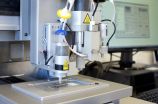(Press-News.org) Lisbon, 17 June 2015: An IVF technique which freezes all embryos generated in an initial treatment cycle and transfers them in a later cycle as freeze-thawed embryos does not improve outcome as some studies have suggested.
Results of the study, performed at the Instituto Valenciano de Infertilidad (IVI) clinic in Valencia, Spain, are presented today at the ESHRE Annual Meeting by Dr Ernesto Bosch, Medical Director of IVI Valencia, Spain.
As background to his report, Dr Bosch noted that several studies have found improved outcomes in IVF when all embryos are electively frozen for later transfer.(1) It has been claimed that this freeze-all approach avoids embryo transfer in the fresh stimulation cycle and thus any adverse effects which ovarian stimulation has on the uterine environment and embryo implantation.
Thus, said Dr Bosch, if endometrial receptivity is indeed diminished during ovarian stimulation, transferring the embryo in a delayed cycle - in which the uterus has not been exposed to supra-physiological doses of reproductive hormones - would appear a reasonable solution.
However, this large Spanish study found no evidence that routinely freezing all embryos and delaying transfer to a subsequent cycle improves IVF outcome in terms of ongoing pregnancy or live birth rates in women with a normal response to ovarian stimulation.(2)
The study included 882 patients having a first or second cycle of IVF at the IVI clinic in Valencia; 364 of them (41%) had embryo transfer in the initial fresh cycle, and 518 (59%) agreed to have all embryos frozen for later transfer. When the outcomes were compared, no differences were observed between ongoing pregnancy rate and live birth rate (36.2% freeze-all vs 33.8% fresh). When adjustments were made for patient age and other variables likely to affect results, there was still no evidence of any impact of freezing. All patients in the study were considered "normal responders" and were thus representative of a routine IVF patient population.
"These findings," said Dr Bosch, "do not support a change in IVF practice moving to a freeze-all strategy in normo-responders in IVF." He further noted that treatment cost and time to pregnancy are both lower in fresh embryo transfers.
However, he noted that there is still good evidence that a freeze-all approach lowers (even removes) the small risk of ovarian hyperstimulation syndrome (OHSS) in IVF, which is increased following conception, but any further benefit in terms of outcome, said Dr Bosch, would need the strong evidence of a randomised trial before a change in policy might be considered.
"Most studies so far," explained Dr Bosch, "have included patients who are high responders to ovarian stimulation with high steroid levels at the end of the follicular phase. These high levels of hormone have been shown to impair the receptivity of the uterus to embryo implantation, and this may explain why these studies have shown a benefit in outcome."(3)
He added that some clinics appear to have introduced freeze-all policies in their routine IVF, but the number is unknown. This study would suggest that there is no outcome benefit in such a strategy in patients who respond normally to ovarian stimulation, but Dr Bosch did emphasise the safety of such an approach in high responders. "We did not include high responders in our study," he said, "and for them we still recommend a freeze-all strategy for preventing both early and late OHSS."
INFORMATION:
Abstract O-162, Wednesday 17 June, 14.15 WEST
Electibe frozen embryo transfer does not improve reproductive outcome in norm0-responder patients
Notes
1. See for example:
Roque M, Valle M, Guimares F, et al. Freeze-all policy: fresh vs. frozen-thawed embryo transfer. Fertil Steril 2015: 103: 1190-1193. This study, in 530 initial treatment cycles, found significantly better outcomes in the freeze-all patients than in the fresh (ongoing pregnancy rate 39.7% vs 31.1%).
2. Most studies of freeze-all strategies in IVF have been in women who seem likely to over-respond to stimulating drugs and who are thus at risk of ovarian hyperstimulation syndrome (OHSS). In cases of high OHSS risk, a freeze-all policy has been show to remove (or minimise) the risk.
3. This may explain the benefit shown in the study by Roque et al cited above.
When obtaining outside comment, journalists are requested to ensure that their contacts are aware of the embargo on this release.
Nyon, Switzerland - June 17, 2015 -- An International Osteoporosis Foundation (IOF) Working Group on Skeletal Rare Diseases has published a new classification of rare genetic metabolic bone disorders (RGMBDs) according to their metabolic pathogenesis.
Skeletal Rare Diseases such as osteogenesis imperfecta, juvenile Paget's disease or osteopetrosis, are only three of the more than 400 developmental abnormalities of the skeletal system that affect patients worldwide. Although rare, these 'orphan' diseases have a very serious, and often devastating, impact on the lives ...
Scientists at the Ruhr-Universität Bochum established a mouse model for the human disease SCA6. SCA6 is characterised by movement deficits and caused by similar genetic alterations as Chorea Huntington. The mouse model will be used to investigate the disease mechanisms. Experiments suggest that an impairment of eye blink conditioning could be an early disease symptom. The team from the Department of Zoology and Neurobiology published their data in the Journal of Neuroscience; the work was highlighted by the editor's commentary.
Spinocerebellar ataxia 6: structural ...
This news release is available in German. Ragweed (Ambrosia artemisiifolia) - an otherwise unremarkable plant - produces pollen that can trigger strong allergic reactions such as asthma even in very small quantities. Scientists from Technische Universität München (TUM) and Helmholtz Zentrum München have now published a joint study showing that the substance previously identified as the major allergen only induces such a vigorous allergic response in combination with the adenosine also present in the pollen.
Ragweed only started to become widespread ...
A group of researchers at Chalmers University of Technology have managed to print and dry three-dimensional objects made entirely by cellulose for the first time with the help of a 3D-bioprinter. They also added carbon nanotubes to create electrically conductive material. The effect is that cellulose and other raw material based on wood will be able to compete with fossil-based plastics and metals in the on-going additive manufacturing revolution, which started with the introduction of the 3D-printer.
3D printing is a form of additive manufacturing that is predicted to ...
Astronomers have long theorised the existence of a first generation of stars -- known as Population III stars -- that were born out of the primordial material from the Big Bang [1]. All the heavier chemical elements -- such as oxygen, nitrogen, carbon and iron, which are essential to life -- were forged in the bellies of stars. This meansthat the first stars must have formed out of the only elements to exist prior to stars: hydrogen, helium and trace amounts of lithium.
These Population III stars would have been enormous -- several hundred or even a thousand times more ...
Scientists have developed a new tissue 'scaffold' technology that could one day enable the engineering of large organs.
Research led by the Universities of Bristol and Liverpool has shown that it is possible to combine cells with a special scaffold to produce living tissue in the laboratory. It is hoped this can then be implanted into patients as a way of replacing diseased parts of the body.
Until now, the approach has generally been limited to growing small pieces of tissue, as larger dimensions reduce the oxygen supply to the cells in the centre.
A team of ...
HOUSTON, June 18 -- Taking research from the lab to the clinic can be a long and arduous process, but necessary to ensure new therapeutic methods are safe. This typically involves models created in the lab to closely resemble the cellular mechanism of the human body.
Researchers at Baylor College of Medicine say they have now created a new disease model that more than just resembles the human mechanisms; it acts as a fully functioning human lipid system within a mouse to specifically study hypercholesterolemia, a form of high cholesterol caused by a genetic defect.
The ...
About a fifth of all U.S. children live in poverty. These children are more likely to experience learning and cognitive delays. Researchers have tried to determine causes for this disparity, with recent work identifying the hormone cortisol as a possible reason because of its ability to pass the blood-brain barrier. Cortisol is one of the most influential hormones in the human body, often referred to as the stress hormone because it's secreted into the bloodstream at higher levels as part of the body's flight-or-fight response. Now a new study has identified how specific ...
Teenagers vary substantially in their ability to control impulses and regulate their behavior. Adolescents who have difficulty with impulse control may be more prone to risky sexual behavior, with serious consequences such as sexually transmitted diseases and unintended pregnancies. A new study has found that individual differences in working memory can predict both early sexual activity and unprotected sexual involvement during adolescence.
Working memory -- the system in the brain that allows individuals to draw on and use information to plan and make decisions -- ...
Migraine researchers and clinicians are growing excited about a new class of drugs called Calcitonin Gene-Related Peptide (CGRP) monoclonal antibodies, which are showing promise in treating high-frequency episodic migraine and chronic migraine.
"This development is a transformative moment in migraine treatment," said Peter J. Goadsby, MD, PhD, who is chair of the scientific program of the American Headache Society's annual Scientific Meeting. Dr. Goadbsy is Chief of the UCSF Headache Center, and one of the world's leading headache treatment experts and researchers. ...

